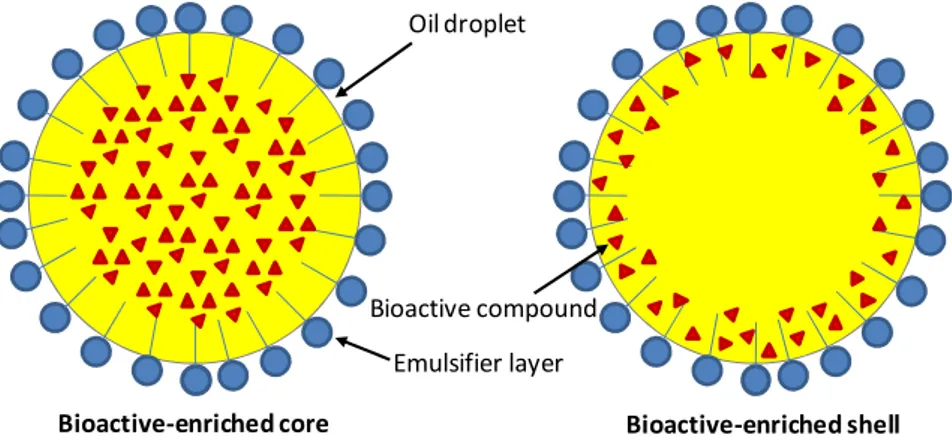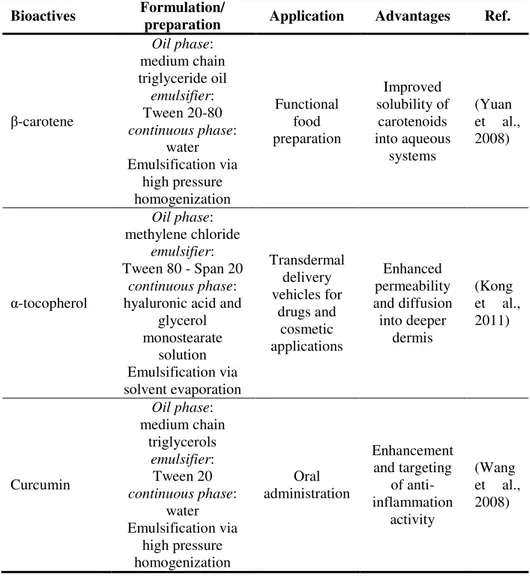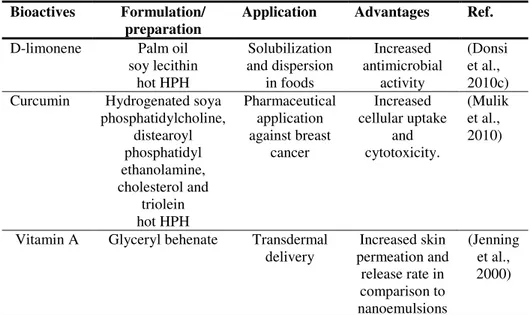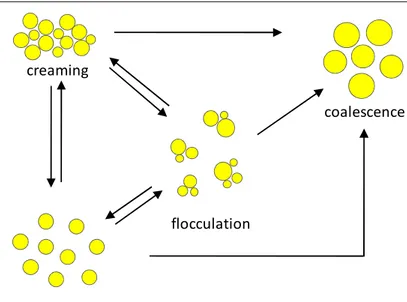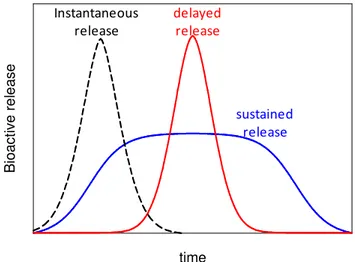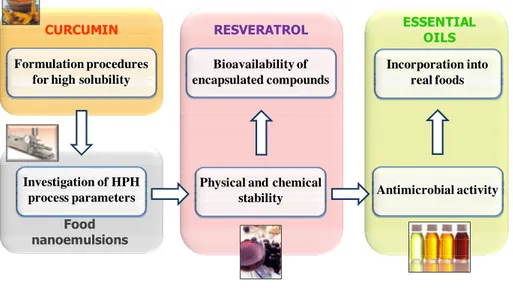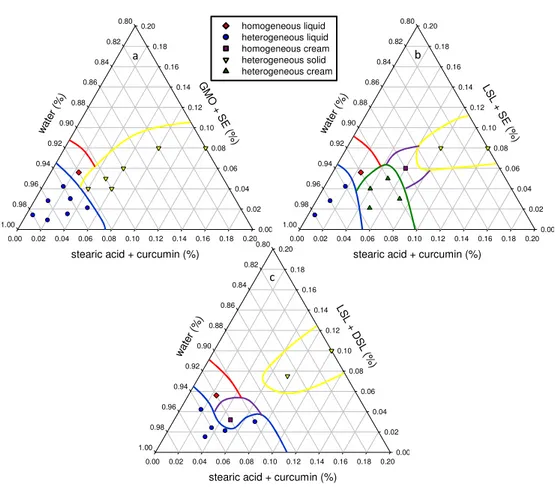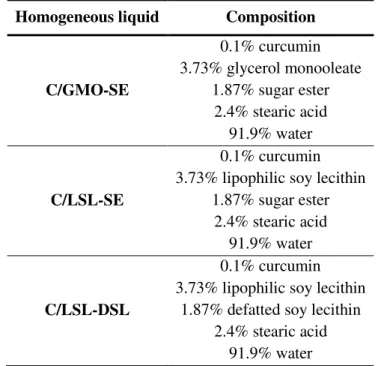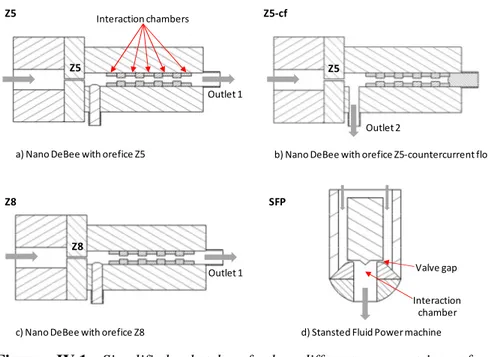Nanoencapsulation of bioactive
compounds for food applications
Unione Europea UNIVERSITÀ DEGLI STUDI DI SALERNO
Department of Industrial Engineering
Ph.D. Course in Chemical Engineering
(X Cycle-New Series)
NANOENCAPSULATION OF BIOACTIVE
COMPOUNDS FOR FOOD APPLICATIONS
Supervisor
Ph.D. student
Prof. Giovanna Ferrari
Mariarenata Sessa
Scientific Referees
Dr. Ing. Francesco Donsì
Dr. Rong Cao
Ph.D. Course Coordinator
“An unexamined life is not worth living” Socrates
Acknowledgements
I gratefully acknowledge the support given by my scientific supervisors, Prof. Giovanna Ferrari and Dr. Francesco Donsì. I wish to thank Prof. Giovanna Ferrari for her professional and scientific advices. A special thanks to Dr. Francesco Donsì for his incomparable guidance and unequaled support, but also for his extreme patience with me in these three years. I’m sincerely grateful to him for having fueled in me the passion for the research and for believing deeply in me.
I also want to express my gratitude to Dr. Rong Cao for kindly inviting me to join his research group at the Guelph Food Research Centre, Agriculture and AgriFood Canada, and for giving me precious suggestions and encouragements. My special thanks to all Dr. Cao’s research group, especially to Dr. Amy Proulx and Dr. Ronghua Liu for being so helpful in the in vitro and ex vivo experiments.
I would like to acknowledge all the people who work and have worked at ProdAl Scarl for sharing with me pleasant days during the whole period of my PhD. Especially thanks to my friend Marianna, to Mariangela Falcone and Mariarosaria Vincensi for their assistance with the HPLC analysis and to Raffaele Taddeo and Luigi Esposito for their help in plant maintenance.
I would like to thank my colleagues who accompanied me through all happy and tough times of our PhD course, and in particular way to my friend Titti with whom I "virtually" shared the long canadian evenings.
Finally, I’m very grateful to my parents, who always supported my choices and helped me to overcome every difficulty.
I would like to dedicate this work to my beloved Saverio, who makes special every moment of my life. Thanks for always being by my side.
Publications
Donsì, F.; Annunziata, M.; Sessa, M.; Ferrari, G. (2011) Nanoencapsulation of essential oils to enhance their antimicrobial activity in foods. Lwt-Food Science and Technology, 44, 1908-1914.
Sessa, M.; Tsao, R.; Liu, R.; Ferrari, G.; Donsì, F. (2011) Evaluation of the
stability and antioxidant activity of nanoencapsulated resveratrol during in vitro digestion. Journal of Agricultural and Food Chemistry, 59, 12352-12360.
Donsì, F.; Sessa, M.; Ferrari, G. (2011) Effect of emulsifier type and disruption chamber geometry on the fabrication of food nanoemulsions by high pressure homogenization. Industrial & Engineering Chemistry Research, in press.
Donsì, F., Sessa, M., Ferrari, G., Mediouni, H., Mgaidi, A. (2011) Encapsulation of bioactive compounds in nanoemulsion-based delivery systems. In: Editors: Taoukis, P.S., Stoforos, N.G., Karathanos, V.T., Saravacos, G.D. Proceedings of the 11th International Congress on Engineering and Food (ICEF11), Athens (Greece), May 22-26, 2011, vol. 1, p. 681-682.
Amendola, D., Donsì, F., Sessa, M., Ferrari, G., De Faveri, D.M., Spigno, G. (2011). Nanoemulsions of grape marc extract as natural additives to improve hazelnut paste shelf-life. In: Editors: Taoukis, P.S., Stoforos, N.G., Karathanos, V.T., Saravacos, G.D. Proceedings of the 11th International Congress on Engineering and Food (ICEF11). Athens (Greece), May 22-26, 2011, vol. 1, p. 165-166.
Donsì, F., Annunziata, M., Sessa, M., Ferrari, G. (2011) Nanoemulsion-based delivery systems for the encapsulation of essential oils to be used as antimicrobials in foods. In: Editors: Tavman, S., Ötleş, S., Baysal, T., Göksungur, Y., Kişla, D., Dirim, N., Koca, N. Proceedings of the
International Food Congress Novel Approaches in Food Industry (NAFI 2011). Cesme (Turchia), May 26-29, 2011, vol. 1, p. 16-21.
Donsì, F.; Sessa, M.; Ferrari, G. (2011) Nanometric-size delivery systems of bioactive compounds for nutraceutical and food industries. In: Bionanotechnology: A Revolution in Biomedical Sciences & Human Health, John Wiley & Sons, submitted.
Sessa, M., Casazza, A.A:, Perego, P., Tsao, R., Ferrari, G., Donsì, F. (2012)
Exploitation of polyphenolic extracts from grape marc as natural antioxidants by encapsulation in lipid-based nanodelivery systems. Food and Bioprocess Technology, submitted.
Sessa, M., Donsì, F, Ferrari, G., Proulx, A., Tsao, R. (2012) Bioavailability
of encapsulated resveratrol into nanoemulsion-based delivery systems. Nanomedicine: Nanotechnology, Biology, and Medicine, submitted.
Oral communications
Encapsulation of bioactive compounds in nanoemulsion-based delivery systems. 11th International Congress on Engineering and Food (ICEF11). Athens (Greece), May 22-26, 2011.
Recent advances in the use of HPH technique @ ProdAl. Advanced in UHPH process (FUNENTECH workshop). Barcelona (Spain), December 15, 2011.
I
Index
List of figures ... V List of tables ... IX Abstract ... XI Chapter IIntroduction and background ... 1
I.1 Interest of the study ... 1
I.2 Food-grade nanometric delivery systems ... 2
I.2.1 Nanoemulsions ... 2
I.2.2 Solid lipid nanoparticles ... 6
I.3 Production of nanometric delivery systems ... 9
I.3.1 High pressure homogenization ... 12
I.4 Protection of bioactive compounds by nanoencapsulation ... 15
I.5 Increase of bioavailability of nanoencapsulated bioactives ... 17
Chapter II Scope of the work ... 21
II.1 Objectives ... 21
II.2 Working plan ... 22
Chapter III Formulation procedures for high solubility ... 25
III.1 Introduction ... 25
III.2 Material and methods ... 27
III.2.1 Materials ... 27
III.2.2 Screening of Emulsion Formulations ... 27
III.3 Construction of a pseudo-ternary phase diagram for the evaluation of stable formulations ... 28
Chapter IV Investigation of HPH process parameters ... 33
IV.1 Introduction ... 33
Contents
II
IV.2.1 Materials ... 36
IV.2.2 Experimental method ... 36
IV.2.2.1 Interfacial tension measurements ... 36
IV.2.2.2 Emulsion production by high pressure homogenization ... 37
IV.2.2.3 Homogenization chamber geometry ... 38
IV.2.2.4 Photon Correlation Spectroscopy ... 39
IV.2.2.5 Viscosity measurement of the nanoemulsions ... 39
IV.2.2.6 Density measurement of the nanoemulsions ... 40
IV.2.3 Data fitting ... 40
IV.2.3.1 Dynamic interfacial tension ... 40
IV.2.3.2 Emulsification process ... 40
IV.3 Results ... 41
IV.3.1 Interfacial tension and adsorption kinetics ... 41
IV.3.2 Effect of emulsifier type and concentration on mean droplet diameter ... 45
IV.3.3 Effect of homogenization chamber geometry on mean droplet size ... 48
IV.4 Discussion ... 51
IV.5 Conclusions ... 56
Chapter V Physicochemical stability of nanoencapsulated bioactives ... 59
V.1 Nanoencapsulation of resveratrol ... 59
V.1.1 Materials and methods ... 61
V.1.1.1 Chemicals ... 61
V.1.1.2 Fabrication of nanoemulsions loaded with resveratrol ... 61
V.1.1.3 Fluorescence spectrum of nanoencapsulated resveratrol ... 62
V.1.1.4 Physical stability ... 62
V.1.1.5 Chemical stability ... 63
V.1.2 Results ... 64
V.1.2.1 Formulation of stable nanoemulsions ... 64
V.1.2.2 Physical stability ... 66
V.1.2.3 Chemical stability ... 68
V.2 Nanoencapsulation of grape marc polyphenols ... 72
V.2.1 Materials and methods ... 73
V.2.1.1 Chemicals ... 73
V.2.1.2 Extraction of grape marc polyphenols ... 73
V.2.1.3 Encapsulation of grape marc polyphenols at the nanoscale .... 74
V.2.1.4 Physical stability ... 74
V.2.1.5 Chemical stability ... 74
V.2.3 Results ... 74
V.2.3.1 Composition of the polyphenols in the grape marc extracts .... 74
V.2.3.2 Physicochemical stability of the nanoencapsulated polyphenolic extracts... 75
Nanoencapsulation of bioactive compounds for food applications
III
V.3 Encapsulation of curcumin ... 81
V.3.1 Materials and methods... 82
V.3.1.1 Chemicals ... 82
V.3.1.2 Fabrication of encapsulated curcumin into emulsion ... 82
V.3.1.3 Physicochemical stability of encapsulated curcumin ... 82
V.3.3 Results ... 83
V.3.3.1 Physicochemical stability of curcumin emulsions ... 83
V.4 Conclusions ... 85
Chapter VI Bioavailability of nanoencapsulated bioactives ... 87
VI.1 Resveratrol and its beneficial effects ... 87
VI.2 Materials and methods ... 89
VI.2.1 Chemicals ... 89
VI.2.2 Production of nanoemulsions for resveratrol delivery ... 89
VI.2.3 In vitro gastrointestinal digestion ... 90
VI.2.4 Cell cultures ... 91
VI.2.5 Transport across filter-grown Caco-2 cell monolayers ... 91
VI.2.6 Cellular uptake ... 92
VI.2.7 In vitro release ... 92
VI.2.8 HPLC analysis ... 93
VI.3 Results ... 93
VI.3.1 In vitro digestion of nanoencapsulated resveratrol ... 93
VI.3.2 Transport through Caco-2 cell monolayers ... 95
VI.3.3 In vitro release of nanoencapsulated resveratrol ... 99
VI.4 Conclusions ... 101
Chapter VII Antioxidant activity of encapsulated compounds ... 103
VII.1 Introduction ... 103
VII.2 Materials and methods ... 105
VII.2.1 Chemicals ... 105
VII.2.2 Chemical antioxidant activity ... 105
VII.2.3 Cellular antioxidant activity ... 106
VII.3 Results ... 107
VII.3.1 Antioxidant activity of nanoencapsulated resveratrol... 107
VII.3.2 Antioxidant activity of encapsulated grape marc polyphenols .. 110
VII.3.3 Antioxidant activity of encapsulated curcumin ... 114
VII.4 Conclusions ... 116
Chapter VIII Antimicrobial activity of nanoencapsulated essential oils ... 117
VIII.1 Essential oils as natural antimicrobials... 117
Contents
IV
VIII.2.1 Materials ... 120
VIII.2.2 Preparation of nanoemulsions ... 120
VIII.2.3 Determination of MIC and MBC ... 121
VIII.2.4 Kinetics of inactivation ... 121
VIII.2.5 GC-MS analysis ... 122
VIII.2.6 Fluorescence microscopy ... 122
VIII.2.7 Shelf life of fruit juices ... 123
VIII.3 Results ... 123
VIII.3.1 Mechanisms of inactivation of encapsulated essential oils ... 123
VIII.3.2 Kinetics of inactivation ... 129
VIII.3.3 Addition of encapsulated antimicrobial agents to fruit juices .. 132
VIII.4 Conclusions ... 135
Chapter IX Conclusions and perspectives ... 137
V
List of figures
Figure I.1 Possible localizations of bioactive molecules into O/W
nanoemulsions. ... 4
Figure I.2 Possible localizations of a bioactive molecules into SLNs. ... 7
Figure I.3 Particle stressing in comminution processes. ... 11
Figure I.4 Schematics of a high pressure homogenization system. ... 13
Figure I.5 Mechanisms of physical instability in nanoemulsions. ... 17
Figure I.6 Schematic mechanism of uptake and bioavailability of nanoencapsulated bioactive compound.... 19
Figure I.7 Mechanisms of release of bioactive compounds... 20
Figure II.1 Sketch of the research activities related to the nanoencapsulation of bioactive compounds... 23
Figure III.1 A generalized formulation–composition map on two-dimensional plot (Salager, 1988). ... 26
Figure III.2 The pseudo-ternary phase diagrams of curcumin–encapsulated emulsion using stearic acid as lipid phase and a combination of (a) lipophilic soy lecithin, LSL, and sugar ester, SE, (b) lipophilic soy lecithin, LSL, and defatted soy lecithin, DSL, and (c) glycerol monooleate, GMO, and sugar ester, SE, as emulsifiers. ... 29
Figure III.3 Samples collected for the evaluation of the stability/instability regions of the pseudo-ternary phase diagram. From left to right: homogeneous cream, heterogeneous cream, heterogeneous solid, heterogeneous and homogeneous liquid. ... 29
Figure IV.1 Simplified sketch of the different geometries of the homogenization chambers tested. ... 38
Figure IV.2 Dynamic interfacial tension, σ, of different emulsifiers, modified starch (a), pea proteins (b), SDS (c), Tween 80 (d), sugar ester (e) and defatted soy lecithin (f), solubilized in water at the following
Contents
VI
concentrations: 10-2 g/L ( ), 10-1 g/L ( ), 1.0 g/L ( ), 10 g/L ( ) and 50 g/L ( ) compared with the dynamic interfacial tension of water in sunflower oil (dashed line). Experimental data are fitted with eq. (IV.4) (solid lines)... ... 43
Figure IV.3. Effect of emulsifier concentration on the mean droplet size,
Z-diameter, as a function of the energy density, EV, for modified starch (a), pea
proteins (b), SDS (c), Tween 80 (d), sugar ester (e) and soy lecithin (f). Experimental data: emulsifier concentration of 2.0 g/L (green symbols), 10 g/L (red symbols) and 50 g/L (black symbols); pressure of 70 MPa ( ), 140 MPa ( ), 210 MPa ( ) and 280 MPa ( ); the number of passes can be calculated as Ev divided pressure. ... 46 Figure IV.4 Parity plots reporting fitted values, according to the models of
eqs. (IV.1) and (IV.5), vs. experimental values of Figure IV.3. ... 47
Figure IV.5 Dependence of the mean droplet size, Z-diameter, of the
emulsion on the energy density, EV, for different geometries of the
homogenization chamber: Z5 (a), Z5-cf (b), Z8 (c) and SFP (d). Experimental data: pea proteins ( ), modified starch ( ), SDS ( ) and Tween 80 ( ) and Cem = 10 g/L. Experimental data are fitted with eq. (IV.1)
(solid lines). ... 49
Figure IV.6 Dependence of the polydispersity index, PDI, of the emulsion
on the energy density, EV, for different geometries of the homogenization
chamber: Z5 (a), Z5-cf (b), Z8 (c) and SFP (d). Experimental data: pea proteins ( ), modified starch ( ), SDS ( ) and Tween 80 ( ) and Cem = 10 g/L. Experimental data are fitted with eq. (IV.6) (solid lines). ... 50 Figure IV.7 Values of the regression coefficients of the different parameters
from linearization of experimental data of HPH-emulsification (eqs. (IV.11) and (IV.12)) (a), and corresponding parity plot, reporting fitted vs. experimental values (b). ... 54
Figure V.1 Fluorescence emission spectra of resveratrol dissolved in water
and encapsulated resveratrol into peanut oil-based nanoemulsion. ... 65
Figure V.2 Evolution of the creaming volume percentage, C, (a, c and e)
and of the mean droplet diameter, Z-diameter, (b, d and f) of the resveratrol-encapsulated nanoemulsions stored at 4 °C (a, b), 30 °C (c, d) and 55 °C (e, f) for 30 days... 67
Figure V.3 The retention percentage of trans-resveratrol, θtrans , (a) and
cis-resveratrol yield, θcis , (b) under UV-C light exposure. ... 69 Figure V.4 The retention percentage of trans-resveratrol, θtrans, at 4 °C (a),
30 °C (b) and 55 °C (c) for 30 days. Different letters in the same day indicate statistically (Student t-test) significant differences (p<0.05). ... 71
Figure V.5 Evolution of the creaming volume percentage, C, of the
encapsulated grape marc polyphenols into different delivery systems: (a) SO/GMO-DSL, (b) SO/LSL-DSL, (c) PO/GMO-DSL and (d) PO/LSL-DSL. Storage temperatures were 4 °C ( ), 30 °C ( ) and 55 °C ( ). ... 79
Nanoencapsulation of bioactive compounds for food applications
VII
Figure V.6 The UV-Vis absorption of the encapsulated grape marc
polyphenols into different nanoemulsions: a) SO/GMO-DSL, b) SO/LSL-DSL, c) PO/GMO-DSL and d) PO/LSL-SO/LSL-DSL, after storage at 1) 4 °C, 2) 30 °C and 3) 55 °C for 14 days. ... 80
Figure V.7 The evolution of the mean droplet diameter, d(0.5), of the
curcumin-encapsulated emulsion under accelerated ageing conditions. ... 83
Figure V.8 The evolution of the UV–Vis absorption curves of the
curcumin-encapsulated emulsion after storage at different temperatures, (a) 4 °C, (c) 30 °C and (e) 55 °C) and different pH, (b) 3, (d) 7 and (f) 10, for 20 days. 84
Figure VI.1 Mean droplet diameter, Z-diameter, of the nanoemulsions
encapsulating resveratrol before and after the in vitro digestion process. .. 94
Figure VI.2 Cumulative amount (Q) versus time (t) of unencapsulated
resveratrol (R/DMSO) and nanoencapsulated resveratrol transported from the apical to the basolateral side across Caco-2 cell monolayers. ... 96
Figure VI.3 Mean droplet diameter (Z-diameter) of the nanoemulsions
encapsulating resveratrol before and after transport across Caco-2 cell monolayers. ... 96
Figure VI.4 The Apparent permeability coefficient, Papp, of unencapsulated
resveratrol (R/DMSO) and encapsulated resveratrol into different nanoemulsion-based delivery systems. ... 98
Figure VI.5 The cellular uptake of unencapsulated resveratrol (R/DMSO)
and encapsulated resveratrol into different nanoemulsion-based delivery systems.... 99
Figure VI.6 Comparison of cumulative release into aqueous medium from
dialysis bags of nanoencapsulated resveratrol with the unencapsulated compound. ... 100
Figure VI.7 The concentration of resveratrol released, in dialysis bag and
chemical degraded after 72 h of in vitro release test. ... 101
Figure VII.1 Antioxidant activity of nanoemulsions containing resveratrol
by FRAP assay (a) and ORAC assay (b) before and after the in vitro digestion process, in comparison with resveratrol dissolved in DMSO (R/DMSO). ... 108
Figure VII.2 Cellular antioxidant activity, CAA unit, of
resveratrol-encapsulated nanoemulsions before and after in vitro digestion. ... 110
Figure VII.3. Chemical antioxidant activity using (a) FRAP assay and (b)
ORAC assay of grape marc polyphenols nanoencapsulated into: ( ) SO/GMO-DSL, ( ) SO/LSL-DSL, ( ) PO/GMO-DSL and ( ) PO/LSL-DSL, in comparison with ( ) unencapsulated grape marc polyphenols dissolved in methanol. Different letters indicate statistically (Student t test) significant differences (p<0.05). ... 112
Contents
VIII
Figure VII.4 Cellular antioxidant activity (CAA unit) of grape marc
polyphenols nanoencapsulated into: ( ) SO/GMO-DSL, ( ) SO/LSL-DSL, ( ) PO/GMO-DSL and ( ) PO/LSL-DSL, in comparison with ( ) unencapsulated grape marc polyphenols dissolved in methanol. Different letters indicate statistically significant differences (p<0.05). ... 113
Figure VII.5 Comparison of the antioxidant activity of encapsulated
curcumin into solid lipid particles, produced by HPH using as emulsifiers lipophilic soy lecithin and sugar ester (C/LSL-SE) or lipophilic and defatted soy lecithin (C/LSL-DSL), with unencapsulated curcumin diluted in DMSO, using (a) FRAP assay, (b) ORAC assay and (c) Cellular Antioxidant Activity assay. ... 115
Figure VIII.1 Brightfield (a and c) and fluorescence micrographs (b and d)
of S. cerevisiae cells exposed to nanoemulsion L/CG captured by fluorescence microscopy after 5 min (a and b) and 24 h (c and d). ... 127
Figure VIII.2 Brightfield (a and c) and fluorescence micrographs (b and d)
of S. cerevisiae cells exposed to nanoemulsion T/SL-HPH captured by fluorescence microscopy after 5 min (a and b) and 24 h (c and d). ... 128
Figure VIII.3 Inactivation curve of L. delbrueckii suspended in (a) orange
juice and (b) pear juice treated with terpenes nanoemulsion T/SL-HPH at 32 °C. Experimental data: control juice ( ), juice added with the nanoemulsion to a final concentration of 1.0 g/L ( ), 5.0 g/L ( ) and 10 g/L ( ) of the terpenes mixture. ... 133
Figure VIII.4 Variation over time of (a and b) pH, (c and d) °Bx and (e and
f) global color difference, ∆E, of (a, c and e) orange juice and (b, d and f) pear juice with different concentrations of terpenes nanoemulsion T/SL-HPH at 32 °C. Experimental data: control juice ( ), juice added with the nanoemulsion to a final concentration of 1.0 g/L ( ), 5.0 g/L ( ) and 10 g/L ( ) of the terpenes mixture. ... 134
IX
List of tables
Table I.1 Examples of nanoemulsion-based delivery systems. ... 5 Table I.2 Examples of solid lipid nanoparticles-based delivery systems. ... 8
Table III.1 Composition of the “homogeneous liquid” systems that has been
used as primary emulsions during the production by HPH of O/W emulsion for curcumin delivery. ... 30
Table IV.1 Kinetic parameters from the fitting of the curves of Figure IV.2
with eq.(IV.4) for different emulsifier types and concentrations. ... 44
Table IV.2 Dependent and independent variables used in the sensitivity
analysis. ... 53
Table V.1 Total polyphenols and main phenolic compounds content
(mg/gDW) and concentration (mg/mlmethanol) in skin extract obtained by HPTE
and analyzed with Folin-Ciocalteau and HPLC. ... 75
Table V.2 Composition, mean droplet size (Z-diameter) and polidispersity
index (PDI) of the stable delivery systems of the grape marc polyphenols. . 76
Table V.3 Evolution of the mean droplet diameter (Z-diameter) of the
encapsulated grape marc polyphenols in sunflower oil-based (SO/GMO-DSL and SO/LSL-DSL) and palm oil-based (PO/GMO-DSL and PO/LSL-DSL) delivery systems, stored at 4, 30 and 55 °C for 14 days. Different lowercase letters in the same day indicate statistically (Student t test) significant differences (p<0.05). Different capital letters at a fixed storage temperature indicate statistically (Student t test) significant differences (p<0.05). ... 78
Table VI.1 Composition and mean droplet diameters, Z-diameter, of the
Contents
X
Table VI.2 Transepithelial electrical resistance measurements (TEER) of
Caco-2 cell monolayers grown on permeable supports before and after transport experiments. ... 97
Table VIII.1 Composition, dimension (Z-diameter) and production method
of the tested nanoemulsions. ... 124
Table VIII.2 MIC and MBC measurements of pure and encapsulated
essential oils on different microbial strains. ... 125
Table VIII.3 The decimal reduction time of inactivation of target
microorganisms exposed to the terpenes mixture encapsulated in T/SL-HPH and T/SL-HSH delivery systems. ... 129
Table VIII.4 Composition of the pure terpenes mixture and the terpenes
XI
Abstract
The increase in dietary-intake-related illnesses, such as obesity, cardiovascular diseases, hypertension, diabetes and cancer, have made in recent years the development of health-and-wellness promoting foods a priority of the food industry. Clinical studies have demonstrated tangible health benefits that may be derived from the intake of bioactive compounds. However many difficulties are associated with their inclusion in food matrices, due to a very low solubility in water and easy degradation by hostile environmental conditions once extracted from plant tissues. Furthermore, poor solubility also means lower absorption in the gastrointestinal tract and, therefore, limited bioavailability. In the food industry, it has become apparent that there is a pressing need for edible delivery system to efficiently encapsulate, protect and release bioactive compounds when developing functional foods.
This thesis was addressed to the study and engineering of nanoencapsulation systems, above all nanoemulsions and solid lipid nanoparticles, with superior capabilities of a) protecting the encapsulated bioactive compounds from interaction with food ingredients, keeping their functional properties and preventing the deterioration of the food itself (i.e. oxidation of fat), b) reducing the impact on the organoleptic properties of food and c) improving the absorption and bioavailability of the bioactives, due to the subcellular size of the nanocapsules, which may potentially enhance passive transport mechanisms (i.e. related to the concentration gradient) across the intestinal wall.
The research activity has contributed to the advance of the knowledge in the field of the science of colloids, through the specific investigation of the effects of formulation and process parameters, which influence nanoemulsion production, as well as to a deeper comprehension of the technological and biological aspects of the incorporation of the nanoencapsulated compounds in food matrices and explication of their activity.
Three different classes of bioactive compounds were chosen as model systems of the experimental work, namely curcumin, resveratrol and essential oils. Both curcumin and resveratrol are antioxidant compounds
Abstract
XII
with markedly low solubility both in aqueous and lipid phase, hence requiring the development of specific formulations. In contrast, essential oils can be easily blended with oils, but require their diffusion through the aqueous phase to attack the cell membrane of microorganisms and act as antimicrobials.
Therefore, novel formulations were developed using a combination of hydrophilic (sugar ester, defatted soy lecithin, polysorbate 20) and lipophilic emulsifiers (soy lecithin, glycerol monooleate) to encapsulate resveratrol in peanut oil droplets and disperse it in aqueous systems at a concentration of 100 mg/L, ten times higher than the therapeutic blood concentration. In the same way, curcumin has been encapsulated in solid lipid particles, using stearic acid as lipid phase, at a maximum concentration 1600 times higher than the solubility of curcumin in water (0.6 mg/L).
Once the formulation was defined, the issue of the actual fabrication of the nanometric delivery systems was faced from a fundamental point of view. In particular, the production of food nanoemulsions by high pressure homogenization (HPH) has been investigated, focusing on the effect on droplet nanonization of emulsifier type and concentration, as well as of the geometry of the homogenization chamber. The reported results showed that the kinetic parameters of the emulsification process can be primarily correlated with the interfacial and dynamic properties of the emulsifiers, while the fluid-dynamics regime established in the homogenization chamber contributes only to a lesser extent. Nevertheless, the correct design of the homogenization chamber may help in obtaining uniform fluid-dynamic conditions, which ensure a narrow droplet size distribution.
The issues related to the physicochemical stability of nanoencapsulated bioactive compounds was faced for resveratrol and curcumin, trying to improve the formulation based on the inputs derived from accelerated ageing studies, that could simulate the food processing and the shelf life of the final product. The results obtained demonstrated that the nanoemulsions based on soy lecithin/sugar esters and Tween 20/glycerol monooleate can better encapsulate resveratrol in the lipid matrix, protecting it both during accelerated ageing and gastro-intestinal digestion and promoting a sustained release. Moreover, these formulations, having smaller mean droplet diameters (below 200 nm), remained physically stable also after the digestion process, allowing the resveratrol to reach the intestinal wall entrapped in the lipid droplets.
The subcellular dimension and the compatibility with cell membranes of the developed formulations also resulted in a higher permeability through the intestinal wall, which was simulated studying the transport through Caco-2 cell monolayers grown on permeable supports. Generally, the apparent permeability of most compounds falls in a range of 1×10-7 cm/sec (poorly
transported compound) to 1×10-5 cm/sec (well-transported compound). The
nanoemulsion-Nanoencapsulation of bioactive compounds for food applications
XIII based delivery systems resulted always in the range indicated, demonstrating that nanoencapsulation can improve passive transport mechanisms. In particular, soy lecithin/sugar esters-based formulation showed an higher permeability due to the presence of soy lecithin, which, having a structure similar to the phospholipid bilayers of the cellular membrane, favours the absorption and the entrapment of the oil droplets in the microvilli and their consequent transport through the cell membrane.
Another remarkable result of the present thesis is that for the first time the effect of the delivery systems on the antioxidant activity of nanoencapsulated compounds was investigated, using a biological-based approach that integrated the classical chemical approaches. More specifically, an improved cellular assay was developed, that enabled to measure exclusively the residual activity of nanoencapsulated bioactive that penetrated inside Caco-2 cells, giving precious information on the combination of the mass transfer promotion and protection by the delivery systems.
Finally, the technological issue related to the incorporation into fruit juices of essential oils encapsulated into nanometric delivery systems was investigated, having as goal the design of systems that are able to enhance antimicrobial activity of the bioactive compounds, while minimizing the impact on the quality attributes of the final product. The results showed that, due to the higher antimicrobial activity of the nanoencapsulated essential oils, lower antimicrobial concentrations are required for a bactericidal action with a minimal alteration of the organoleptic properties of the juice.
1
Chapter I
Introduction and background
I.1 Interest of the study
Several factors sustain the exponential growth of functional foods and nutraceuticals registered during the last years in the world food market, such as the increasing demand of the Western societies for natural products, together with the increasing consumers’ awareness that eating habits should not be merely based on the nutritive aspects of the food, but also on the health-beneficial effects that may derive from its consumption.
Therefore, incorporation in foods and in nutraceutical formulations of bioactive compounds, in order to improve food quality, such as shelf-life, taste or aspect, without the need of synthetic additives, as well as to develop novel functionalities, especially related to health promotion, such as antioxidant, antiradical and antitumor abilities, is highly desired from manufacturing companies and is object of intensive investigations from food scientists, food engineers and food technologists.
In particular, the issues related to efficiently delivering bioactive compounds through the food matrices, improving their uptake and bioavailability, while minimizing the impact on the organoleptic and qualitative properties of the products, call for a heavy involvement of nanotechnology in the development of suitable encapsulation systems.
Currently, the market of nanotechnology products in the food industry is worth about US$ 1 billion, including mainly nanometric delivery systems of bioactive compounds, applied to packaging coatings, to health promoting products, as well as to beverages, and it is foreseen to grow to more than US$20 billion in the next decade (Chau et al., 2007).
In this chapter, the nanometric size delivery systems most suitable for food applications will be discussed, such as nanoemulsions and solid lipid nanoparticles, focusing on high pressure homogenization as production method. Finally, it will be highlighted the ability of the nanoencapsulation to increase the dispersion in aqueous systems of bioactive compounds, which are poorly soluble in water, to protect them from chemical degradation, to
Chapter I
2
improve their antioxidant and antimicrobial activities and to increase their bioavailability.
I.2 Food-grade nanometric delivery systems
The development of functional foods through the addition of bioactive compounds holds many technological challenges. There is a pressing need for edible delivery system to encapsulate, protect and release bioactive compounds within the food industry. From a technological point of view, an efficient nanometric size delivery system should benefit from the following characteristics (McClements et al., 2007):
• Food grade ingredients: the delivery system should be formulated with food-grade, possibly all-natural, ingredients using solvent-free fabrication methods. In particular, one major challenge is to replace some of the polymers and surfactants used in the pharmaceutical industry with food-grade alternatives (Acosta, 2009).
• Food incorporation: the delivery system should be able to incorporate the bioactive compounds into the food matrices with high physicochemical stability and minimal impact on the organoleptic properties of the product (Donsi et al., 2011a).
• Protection against degradation: the delivery system should be able to protect the encapsulated bioactive compounds from the interaction with other food ingredients, as well as from degradation due to temperature, light, pH, during food manufacturing, storage, and preparation (McClements et al., 2007).
• Uptake and bioavailability: the delivery system should maximize the uptake of the encapsulated compounds upon consumption and their transport to the sites of action (Acosta, 2009). In addition, controlled release in response to specific environmental stimulus may be desirable (McClements et al., 2007).
• Industrial scalability: the fabrication of the delivery systems should be easily scalable to industrial production (Donsi et al., 2010a, Donsi et al., 2010d).
In the following, the nanometric size delivery systems most suitable for food applications, such as nanoemulsions and solid lipid nanoparticles, will be discussed.
I.2.1 Nanoemulsions
Nanoemulsions are heterogeneous systems consisting of two immiscible liquids, with one liquid phase being dispersed as nanometric droplets into another continuous liquid phase and stabilized through an appropriate emulsifier. In particular, O/W nanoemulsions, which are of prevalent interest
Introduction and background
3 for food delivery systems, are composed of oil droplets dispersed in an aqueous medium and stabilized by a food-grade surfactant or biopolymeric layer, with mean droplet size typically ranging from 20 to 200 nm (Sagalowicz and Leser, 2010, Chen et al., 2011). The selection of emulsifier type is important to control the interfacial properties (charge, thickness, droplet size and rheology), as well as the response of nanometric oil droplets to environmental stresses (pH, ionic strength, temperature and enzyme activity).
Differently from microemulsions, which are thermodynamically stable systems and form spontaneously, nanoemulsions are kinetically stable and require energy to be formed. Due to their being metastable systems, nanoemulsions can be diluted with water without any change occurring in the droplet size distribution. Nanoemulsions are in fact highly stable to gravitational separation thanks to the small droplet sizes, which means that Brownian motion effects dominate over gravitational forces (McClements, 2005). In addition, nanoemulsions show a lower tendency to droplet aggregation than conventional emulsions, because the strength of the net attractive forces acting between droplets usually decreases with decreasing droplet diameters (McClements, 2005). However, coalescence phenomena due to Ostwald ripening can affect nanoemulsions stability, leading to a significant growth in droplet size over time. Ostwald ripening is a mechanism whereby the larger droplets grow at the expense of the smaller ones because of molecular diffusion of oil between droplets through the continuous phase. This process is driven by the Kelvin effect where the small lipid droplets have higher local oil solubility than the larger droplets, because of the difference in Laplace pressure (Wooster et al., 2008).
Therefore, being its rate dictated by the solubility of the oil in the continuous phase, Ostwald ripening can be kept at minimum by selecting oil with low aqueous phase solubility. More specifically, the aqueous phase solubility of oils decreases linearly with increasing oil molar volume: therefore, nanoemulsions based on low molar volume oils are more likely subjected to Ostwald ripening destabilization than nanoemulsions based on large molar volume oils consisting of long chain triglycerides. When formulation with an oil relatively soluble in the continuous phase cannot be avoided, such as in the case of essential oils nanoemulsions, Ostwald ripening can be reduced by adding a second oil with lower water solubility, in order to change the partitioning of the most soluble oil between lipid and aqueous phase (Sagalowicz and Leser, 2010).
The nanoencapsulation of bioactive compounds in O/W nanoemulsions is an effective approach for incorporating poorly water-soluble compounds in foods. The bioactive molecules, depending on the formulation used, in terms of ingredients and composition, as well as preparation procedures, might have different localizations within an O/W nanoemulsion. For example, the bioactive compound can be entrapped in the inner oil phase
(bioactive-Chapter I
4
enriched core) or can diffuse into the outer stabilizer film (bioactive-enriched shell), as shown in Figure I.1. Its localization influences the stability, release and the bioavailability of the nanoencapsulated compound.
The migration of the bioactive molecules from the inner oil phase to the stable surfactant layer of O/W nanoemulsions, as a consequence of more intense production conditions by high pressure homogenization (increasing number of passes and higher processing temperatures) is reported to increase the protection of bioactive molecules against chemical degradation (Baspinar et al., 2010). On the other side, the entrapment of the bioactive molecules in the emulsifier layer is likely to reduce the possibility of a controlled release mechanisms.
Oil droplet
Bioactive compound Emulsifier layer
Bioactive-enriched core Bioactive-enriched shell
Figure I.1 Possible localizations of bioactive molecules into O/W nanoemulsions.
In general, the immobilization of bioactive compounds in the lipid matrix of the nanoemulsions, thanks to the nanometric size of the encapsulation system, can potentially contribute: (a) to improve the dispersibility of poorly water soluble compounds in aqueous solutions, minimizing the tendency to separate the different phases (aqueous and lipid); (b) to protect the bioactive compounds by interaction with food ingredients, keeping their functional properties and preventing the deterioration of the food itself (i.e., oxidation of fat); (c) to reduce the impact on the organoleptic properties of food; (d) to improve the absorption and bioavailability of the encapsulated bioactive compound, thanks to the subcellular size of the nanocapsules, which enhances passive transport mechanisms (related to the concentration gradient) across the cell membrane.
In Table I.1, some example of applications of nanoemulsions to the delivery of bioactive compounds are reported, with special emphasis on some of the above aspects.
Introduction and background
5 For example, O/W nanoemulsions produced by high pressure homogenization technique were reported to improve the solubility in water of carotenoids, such as β-carotene (Yuan et al., 2008).
Alcohol-free O/W nanoemulsions, using hyaluronic acid as stabilizer, were developed for transdermal delivery of lipophilic active ingredients, such as α-tocopherol (Kong et al., 2011), demonstrating that, without any chemical enhancers, a good skin permeability can be achieved, with improved mass transfer through the stratum corneum and deep diffusion into the dermis.
Table I.1 Examples of nanoemulsion-based delivery systems.
Bioactives Formulation/
preparation Application Advantages Ref.
β-carotene Oil phase: medium chain triglyceride oil emulsifier: Tween 20-80 continuous phase: water Emulsification via high pressure homogenization Functional food preparation Improved solubility of carotenoids into aqueous systems (Yuan et al., 2008) α-tocopherol Oil phase: methylene chloride emulsifier: Tween 80 - Span 20 continuous phase:
hyaluronic acid and glycerol monostearate solution Emulsification via solvent evaporation Transdermal delivery vehicles for drugs and cosmetic applications Enhanced permeability and diffusion into deeper dermis (Kong et al., 2011) Curcumin Oil phase: medium chain triglycerols emulsifier: Tween 20 continuous phase: water Emulsification via high pressure homogenization Oral administration Enhancement and targeting of anti-inflammation activity (Wang et al., 2008)
Chapter I
6
Nanoemulsions were also shown to enhance the beneficial effects of encapsulated bioactive compound when orally administered. For example, using a mouse ear inflammation model, anti-inflammation activity of curcumin was shown to be better targeted, when encapsulated in O/W nanoemulsions. In particular, the synergistic combination of two key features of the nanoemulsion-based delivery system, such as the nanometric droplet size and the presence of a lipid (medium chain triglycerides) in the emulsion formulation, enhanced both the transport through the intestinal walls and cell uptake, allowing the orally-administred curcumin to reach the target sites (the mouse ears) to explicate their full anti-inflammation activity (Wang et al., 2008).
Additional nanoemulsion applications involve sublingual and intranasal delivery of drugs, exploiting the mucoadhesive properties and the ability to enhance the permeability of the mucous layer through an adequate interfacial formulation (Kumar et al., 2008).
The deposition of a multiple layer of emulsifiers and/or polyelectrolytes around nanoemulsion oil droplets via layer-by-layer electrostatic deposition technique may positively affect the absorption properties in the gastrointestinal tract (McClements and Li, 2010).
Different types of primary stabilizers as well as biopolymers for subsequent layer-by-layer deposition were used in order to provide the right properties to emulsion droplets for successful applications, such as low molecular weight surfactants, proteins, polysaccharides.
I.2.2 Solid lipid nanoparticles
Solid lipid nanoparticles (SLNs) are similar to the nanoemulsions, consisting of emulsifier coated lipid droplets dispersed within an aqueous phase, with the main difference that the lipid phase is at the solid or semi-solid state.
In general, to produce loaded SLNs, a lipid phase, where the bioactive compounds have been dispersed, is emulsified in aqueous phase at about 10 °C above the melting point of the lipid, via common dispersing techniques, such as colloid milling, ultrasound, solvent evaporation and high pressure homogenization (HPH).
In particular, the HPH technique has emerged as the most reliable and powerful technique for the preparation of SLNs (Mehnert and Mader, 2001), with two approaches being mainly used: hot and cold homogenization. Hot homogenization is carried out at temperatures above the melting point of the lipids obtaining an hot O/W nanoemulsion, which is then rapidly cooled at room temperature to induce fat crystallization. In contrast, in cold homogenization a coarse dispersion of lipids at solid state is mechanically comminuted to the nanosize and subsequent dispersed in a aqueous solution in presence of a suitable emulsifier. With the cold homogenization method,
Introduction and background
7 the thermal exposure of the encapsulated compounds is minimized, but larger particles and broader size distribution are obtained, in comparison to hot homogenization (Mehnert and Mader, 2001).
The main difficulty associated with the repeatability of the SLNs production is associated to the control of the lipid crystallization, which is significantly dependent on the temperature history of the system, on the presence of impurities in the lipid phase, as well as on droplet size (Sagalowicz and Leser, 2010).
In comparison to nanoemulsions, SLNs exhibit an increased chemical protection against degradation, a higher encapsulation efficiency (> 90%) and a better controlled release, due to the immobilization of the encapsulated bioactive compound in the solid lipid matrix. As schematically shown in Figure I.2, the bioactive compounds within solid lipid nanoparticles can be either dispersed in the interstices of the fat crystals (bioactive-enriched core), or on the surface of the lipid nanoparticle protected by the emulsifier layer (bioactive-enriched shell) (Fathi et al., 2011).
Lipid crystals
Bioactive compound Emulsifier layer
Bioactive-enriched core Bioactive-enriched shell
Figure I.2 Possible localizations of a bioactive molecules into SLNs.
Whether a bioactive enriched core or a bioactive enriched shell is formed depends on the solid lipid phase. A lipid phase consisting of fats of different types and with different properties as well as crystallization kinetics, will exhibit an inner core characterized by voids and defects of the crystalline structure, where the bioactive molecules can be preferentially hosted. In contrast, a lipid phase with a more ordered crystalline structure, for example consisting of a single type of fats, will offer less space for the bioactive molecules. In this case, during crystallization upon lipid cooling, the bioactive compounds are phase separated, either enriching the emulsifier shell or being expelled into the aqueous phase.
SLNs with a bioactive-enriched core are able to keep the encapsulated bioactive compounds away from any hydrophilic reactive species dispersed
Chapter I
8
in the aqueous phase, as well as to promote a sustained release of the encapsulated active material upon oral administration (Muller et al., 2002).
On the other side, SLNs with a bioactive-enriched shell are more indicated to provide a delayed release of the bioactive compounds.
Typically, two or more lipids with different melting points, e.g., mixtures of purified triglycerides, waxes or fatty acids, are used rather than an individual lipid to increase the loading capacity and retention of encapsulated lipophilic components, which can fit better into the more imperfect crystalline structure formed (Schubert and Muller-Goymann, 2005).
Further development of the SLNs brought to the so-called nanostructure lipid carriers, consisting of a disperse phase made of a mix of solid and liquid lipids (Muller et al., 2002). The nanostructure lipid carriers, due to the decreased melting point of the lipid phase, can be produced at lower temperatures, reducing the extent of degradation of the thermolabile compounds. Moreover, they are also claimed to have smaller particle sizes than SLNs, as well as to exhibit a sustained release mechanism in the gastrointestinal tract (Zhuang et al., 2010).
Table I.2 shows some examples of SLN-based delivery systems for applications in different fields, such as food, pharmaceutics and cosmetics.
Table I.2 Examples of solid lipid nanoparticles-based delivery systems.
Bioactives Formulation/ preparation
Application Advantages Ref.
D-limonene Palm oil soy lecithin hot HPH Solubilization and dispersion in foods Increased antimicrobial activity (Donsi et al., 2010c) Curcumin Hydrogenated soya
phosphatidylcholine, distearoyl phosphatidyl ethanolamine, cholesterol and triolein hot HPH Pharmaceutical application against breast cancer Increased cellular uptake and cytotoxicity. (Mulik et al., 2010)
Vitamin A Glyceryl behenate Transdermal
delivery permeation and Increased skin release rate in comparison to nanoemulsions (Jenning et al., 2000)
Introduction and background
9 SLNs formulated with palm oil and soy lecithin were successfully used to increase the dispersibility and antimicrobial activity of essential oils, as well as to incorporate them into fruit juices, with minimal impact on the organoleptic properties of the product (Donsi et al., 2010c).
However, SLNs are underused for food applications, because they require the formulation with solid lipids, such as saturated ones, which are not preferred in terms of nutrition and health (Sagalowicz and Leser, 2010).
For pharmaceutical applications, SLNs are intensively studied in the field of controlled drug release.
The therapeutic efficacy of curcumin encapsulated in transferring conjugated solid lipid nanoparticles was tested against breast cancer, with the results that the cellular uptake was increased and the sustained release of the encapsulated curcumin was favored (Mulik et al., 2010).
In addition, SLNs were also used to control the penetration of several bioactive compounds into the skin, making them attractive for cosmetic applications and topical delivery. For example, skin permeation and release rate of vitamin A was increased when encapsulated into SLNs instead of nanoemulsions (Jenning et al., 2000).
I.3 Production of nanometric delivery systems
Nanometric size delivery systems can be produced by a top-down approach, by mechanical comminution of larger entities into homogeneously sized particles with desired functional properties (i.e. nanoemulsions and solid lipid nanoparticles), by bottom-up approach, assembling the molecular building blocks into structured systems (i.e. micelles, microemulsions, some biopolymeric nanoparticles), as well as by a mixed approach, where molecular assembly and nanonization are combined together (i.e. liposomes, cubosomes, hexosomes, some biopolymeric nanoparticles, multilayer emulsions).
The bottom-up approach is based on self-assembling of molecules into nanometric structured systems exhibiting functional properties, in a process driven by the balance of attraction and repulsion forces tending to thermodynamic equilibrium.
The forces between the building blocks can be controlled by environmental factors, such as temperature, concentration, pH and ionic strength of the system, as well as applying external stimuli, such as pressure, shear or electric and magnetic fields (Sanguansri and Augustin, 2006), with the input of mechanical energy being limited to keep the system perfectly mixed (Acosta, 2009).
Since the nanostructures formed through bottom-up approach exist at the thermodynamic equilibrium, any environmental modification would bring to nanostructures disassembly, therefore limiting their use and incorporation in real food systems, which involves mixing with other ingredients and
Chapter I
10
thermal, pressure or shear stresses during product manufacturing. As a consequence, a stabilization step is required, to freeze the self-assembled nanostructures in the desired size and functional state. Such stabilization step can be conducted through physical or chemical changes, such as rapid quench cooling, sudden solvent dilution or evaporation, as well as chemical reactions, which are required to be more rapid than the system kinetics of attaining a novel equilibrium state.
In the fabrication of nanostructured delivery systems via bottom-up approaches, the poorly water-soluble bioactive compound is first dissolved or dispersed in an organic solvent, and then precipitated through a non-solvent addition, which is typically water for food applications, in the presence of stabilizers, such as surfactants or hydrocolloids (Acosta, 2009, Gao et al., 2011). Eventually, a polymer, which is soluble in the internal solvent but insoluble in the external one, may be added to the system (Acosta, 2009).
The precipitation of the bioactive compound in nanoparticles may be induced by rapid solvent diffusion into the aqueous phase, such as in supercritical fluid technology, by evaporative precipitation into aqueous solution, spray-freezing into liquid process, and emulsion-solvent evaporation.
On the other side, the top-down approaches for the production of nanometric particulate systems are mainly based on comminution by mechanical size reduction techniques without using chemical solvents.
Figure I.3 reports a schematization of the different types of particle stressing exerted in comminution processes.
At macroscopic level, comminution can be carried out by stressing the particles to be disrupted between two surfaces through the combination of compression and shear, in systems such as roller mills and media mills. Obviously in this case the minimum achievable particle size depends on the coupling of the mill surfaces that exert the stress, and, in general, it is > 1 mm.
In order to obtain finer particles, comminution should be based on more focused particle stressing. For example, in impact mills the particles are accelerated towards a surface where they impact, with the stress intensity depending on the kinetic energy of the particles.
An even more focused particle or droplet stressing is based on the transmission of the stress to the particles through a surrounding fluid, where intense fluid mechanical stresses occur. The energy is transferred from the sheared, elongated, or turbulent fluid to the particles, with a stress intensity significantly smaller than in the case of contact with solid surface, but of significantly higher efficiency.
Introduction and background
11
Figure I.3 Particle stressing in comminution processes.
In particular, the most used systems for nanonization processes in the food and nutraceutical industry, colloid or media milling and high pressure homogenization, are based mainly on stress transmission through a surrounding fluid, eventually in combination with the impact on solid surfaces.
Particle stressing through non-mechanical energies, such as electrical or thermal, at the moment do not represent viable systems for the production of nanometric particles and droplets.
Comminution processes are very energy-intensive, with the required energy exponentially increasing at decreasing the particle size. In fact, as the particle size decreases, the number of defects that allow crack propagation and particle disruption is reduced and the intermolecular forces significantly increase.
On the other side, mechanical nanonization processes require minimal use of chemical additives in the formulation of nanometric systems, which represents the main advantage over chemical comminution processes (Acosta, 2009).
Current challenges to the nanonization processes are the efficient use of shear or particle collision to break down larger entities in fine nanoscale
Chapter I
12
aggregates with minimal energy consumption, while preventing re-aggregation and segregation of small and large particles (Acosta, 2009). At the same time, the issues of industrial scalability and cost-effectiveness attract increasing interest, in view of the transfer of the technology to the market.
I.3.1 High pressure homogenization
High pressure homogenization (HPH) is the most suitable currently available technique for the production of uniformly nanosized emulsions, suspensions and dispersions, when evaluated in terms of ease of operation, industrial scalability, reproducibility and high throughput (Schultz et al., 2004).
The high pressure homogenization process can be described as the production of a homogeneous size distribution of particles or droplets suspended in a liquid, by forcing the liquid under the effect of high pressure through a specifically designed disruption chamber.
A typical HPH system consists therefore of a high-pressure generator, a disruption or homogenization chamber, as well as a temperature control system, as shown in the simplified schematics of Figure I.4. From the feed tank, the process liquid is pressurized in a set of pressure intensifiers, such as positive-displacement pumps coupled with piston-cylinder pressure intensifiers, whose phase-delayed movement guarantees an almost uniform flow at the desired pressure level.
HPH working pressures are in the range of 100-300 MPa, with higher operating pressures requiring an increase in equipment costs, which is not balanced by a significant gain in size reduction of the processed emulsions and suspensions.
The homogenization chamber, where the emulsion droplets are disrupted into finer droplets due to the fluid-mechanical stresses generated by the sudden pressure drop, can be realized in different geometries, ranging from a simple orifice plate to colliding jets and radial diffuser assemblies (Schultz et al., 2004). In Figure I.4, some examples of valve geometries are also given.
The simplest valve geometry is represented by an orifice plate of appropriate size to generate the desired pressure level at the process flow rate. Because of their simplicity, orifice valves are widely used in hands-on experimental systems (Brosel and Schubert, 2000) as well as in commercial units (Bee International, Inc., USA).
In the flat-bead valve assembly (Figure I.4-V1), typical of Manton– Gaulin APV (USA), Emulsiflex Avestin (Canada) and GEA Niro Soavi (Italy) commercial models, the process fluid is radially and outwardly dispersed through a narrow gap between the valve piston and seat, with the resulting jet impinging on an impact ring. The flat-bead valve assembly is widely used in the preparation of nanosuspensions (Donsi et al., 2010d,
Introduction and background
13 Moschwitzer et al., 2004), nanoemulsions (Donsi et al., 2010c) and solid-lipid nanoparticles (Souto et al., 2005).
Another valve assembly, which is a hybrid between a radial diffuser and a colliding jet assembly, is sketched in Figure I.4-V2. In such homogenization valve, equipping commercial models of Stansted Fluid Power Ltd (UK), the radial jet originating around the pressurized valve piston, converges to the inner core of the valve, where reciprocally colliding jet fringes contribute to increase the fluid dynamic stresses on the fluid. This geometry resulted more efficient in cell disruption (Donsi et al., 2009) than in nanoemulsion formation (Donsi et al., 2011c).
Chapter I
14
The colliding jet assembly shown in Figure I.4-V3 shows the simplified schematics of the interaction chambers of Microfluidizer (Microfluidics Corp., USA) systems. The pressurized process fluid is divided into two microchannels and then recombined in a reacting chamber where the liquid jets collide, dissipating the energy input almost instantaneously at the point of impact. As the reaction chamber of the microfluidizer is static and contains no moving parts, a high level of reproducibility is ensured in nanoemulsion preparation (Paquin, 1999). On the other side, processing of dispersions and suspensions is limited by the impossibilities of unclogging by varying the gap opening (i.e. by moving the valve piston).
An efficient heat exchanging system is required immediately downstream of the homogenization chamber to cool down the process fluid, whose temperature is increased proportionally to the pressure drop due to frictional heating (0.15-0.20 °C/MPa), in order to prevent the degradation of thermolabile compounds. In addition, temperature control of the process fluid upstream of the pressurization stage may be needed when multiple HPH passes are performed to reach the desired particle or droplet size distribution, as well as in the production of solid lipid nanoparticles, when the temperature should be consistently maintained above the melting temperature of the lipids to avoid their uncontrolled crystallization in the system and consequent clogging.
Droplet or particle break-up occurs in the homogenization chamber thanks to droplet deformation, induced by the fluid-dynamic stresses arising from the combination of turbulence, elongational and shear stress, as well as cavitation within the homogenization chamber.
In standard homogenization chambers, such as radial diffusers or Microfluidizer chambers, the inertial forces in the turbulent flow determined by the valve geometry are mainly responsible for droplet disruption, together with cavitation induced by pressure and velocity fluctuations (Shirgaonkar et al., 1998). In contrast, in orifice valves, where a laminar flow region is established due to the small size of the orifice gap (in some cases as low as 100 µm), break-up can be ascribed to shear forces in elongational flow, as well as to the perturbation occurring in the region following the elongational flow.
The severity of the HPH process and hence the intensity of the fluid-mechanical stresses can be regulated by controlling the operating pressure, the number of passes through the disruption valve, the inlet temperature, as well as the homogenizer valve design, while the scale of operation does not appear to influence the extent of particle break-up, as shown in the case of microorganism cells (Donsi et al., 2009).
In general, the flow regime established in the HPH valve and downstream controls the extent of mechanical disruption of suspended particles and microbial cells with break-up occurring when the fluid-dynamic stresses exceed the particle or cell wall resistance.
Introduction and background
15 In contrast, the emulsification process by HPH consists of two phenomena: the deformation and disruption of the droplets and the consequent droplet stabilization due to the adsorption of the emulsifier molecules at the newly formed O/W interfaces (Brosel and Schubert, 2000). Consequently, product properties and, in particular, the rate of adsorption of emulsifier at the newly formed interfaces contribute to control the size distribution of the nanoemulsion droplets.
Especially in the case of food applications, where the product formulation poses severe limits to the amount and type of emulsifiers to be used, recoalescence phenomena can be problematic. As a consequence, the advantage of a high-pressure homogenization chamber in comparison with another is not the more efficient droplet break-up, but rather droplet stabilization against coalescence after disruption (Schultz et al., 2004).
In the comminution of solid particles into nanoparticles, high pressure homogenization results in lower polydispersity than media milling, which instead require a stage of removal of microparticles and of the residues of abrasion of the used beads or balls.
High pressure homogenization can therefore be considered a highly-recommended technique to reduce particle size efficiently with high reproducibility and to process highly concentrated systems. It can be widely applied to create stable nanoemulsions, as well as dispersions of solid nanoparticles. Moreover, HPH technique enjoys various advantages such as simplicity, high efficiency and needlessness of organic solvents.
I.4 Protection of bioactive compounds by nanoencapsulation
The protection of bioactive compounds against degradation and interaction with food ingredients occurs through the encapsulation in nanometric delivery systems. For this reason an efficient nanodelivery system must be stable in the food matrices over long periods of time. However, some of the conditions that a nanoemulsion encounters during processing (e.g. heating, high-shear mixing) are not conducive to stability. Therefore it is necessary to understand, and ideally to eliminate, the sources of instability in such nanometric delivery systems.
A nanoemulsion may become unstable due to different types of physical and chemical processes. Physical instability, such as creaming, flocculation, coalescence, phase inversion, results in an alteration of the spatial distribution or structural organization of the molecules, whereas chemical instability, such as oxidation and hydrolysis, results in the alteration of the type of molecules present.
Instability during nanoemulsion formation occurs if there is insufficient surfactant to cover the entire oil-water interface created by the homogenizer.
